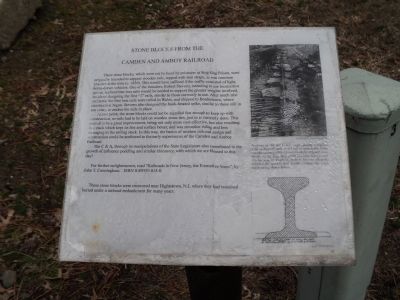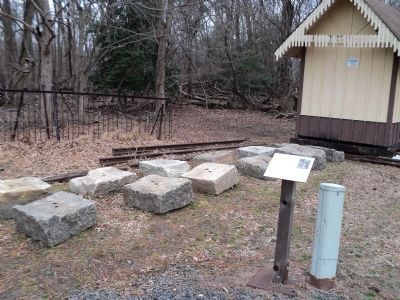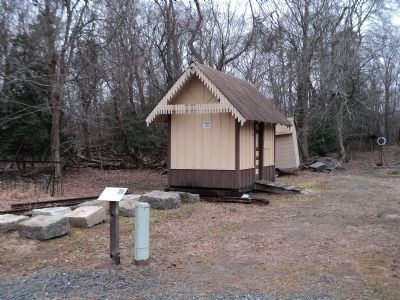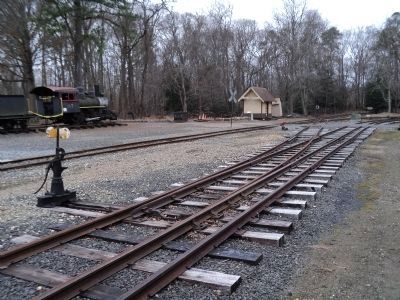Wall Township in Monmouth County, New Jersey — The American Northeast (Mid-Atlantic)
Stone Blocks from the Camden and Amboy Railroad
Inscription.
These stone blocks, which were cut by hand by prisoners at Sing Sing Prison, were originally intended to support wooden rails, topped with iron straps, as was common practice at the time (c. 1830). This would have sufficed if the traffic consisted of light, horse-drawn vehicles. One of the founders, Robert Stevens, intending to use locomotive power, realized that iron rails would be needed to support the greater weight involved, set about designing the first “T” rails, similar to those currently in use. After much trial and error, the first iron rails were rolled in Wales, and shipped to Bordentown, where construction began. Stevens also designed the hook-headed spike, similar to those still in use today, to anchor the rails in place.
At one point, the stone blocks could not be supplied fast enough to keep up with construction, so rails had to be laid on wooden cross-ties, just as is currently done. This proved to be a great improvement, being not only more cost-effective, but also resulting in a track which kept its line and surface better, and was smoother riding and less damaging to the rolling stock. In this way, the basics of modern railroad design and construction could be attributed to the early experiences of the Camden and Amboy Railroad.
The C & A, through its manipulations of the State Legislature also contributed to the growth of influence peddling and similar chicanery, with which we are blessed to this day!
For further enlightenment, read “Railroads in New Jersey, the Formative Years”, by John T. Cunningham. ISBN 0-89359-015-0.
These stone blocks were recovered near Hightstown, N.J., where they had remained buried under a railroad embankment for many years.
Erected by New Jersey Museum of Transportation and the Pine Creek Railroad.
Topics. This historical marker is listed in this topic list: Railroads & Streetcars.
Location. 40° 9.552′ N, 74° 7.834′ W. Marker is in Wall Township, New Jersey, in Monmouth County. Marker can be reached from County Route 524, on the left when traveling west. Marker is located in the NJ Museum of Transportation, Pine Creek Railroad in Allaire State Park. Touch for map. Marker is in this post office area: Farmingdale NJ 07727, United States of America. Touch for directions.
Other nearby markers. At least 8 other markers are within walking distance of this marker. 3-Sided Watchman’s Shanty (within shouting distance of this marker); Freneau Station (within shouting distance of this marker); Union Newsstand (about 300 feet away, measured in a direct line); PRR Watchman’s Shanty (about 400 feet away); Allentown Station (about 400 feet
away); Church (about 700 feet away); Songs Of The Season (approx. 0.2 miles away); Allaire Village (approx. 0.2 miles away). Touch for a list and map of all markers in Wall Township.
Also see . . . A History of the New Jersey Museum of Transportation and the Pine Creek Railroad. The New Jersey Museum of Transportation website. (Submitted on March 4, 2012, by Bill Coughlin of Woodland Park, New Jersey.)
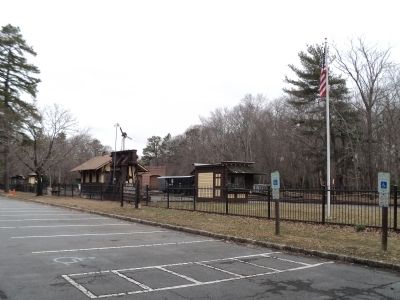
Photographed By Bill Coughlin, March 2, 2012
6. NJ Museum of Transportation and the Pine Creek Railroad
The Stone Blocks and marker are located in the NJ Museum of Transportation in Allaire State Park. In service for more than 50 years, the Pine Creek RR is the oldest continuously-operated steam preservation railroad in the US.
Credits. This page was last revised on February 7, 2023. It was originally submitted on March 4, 2012, by Bill Coughlin of Woodland Park, New Jersey. This page has been viewed 814 times since then and 12 times this year. Photos: 1, 2, 3, 4, 5, 6. submitted on March 4, 2012, by Bill Coughlin of Woodland Park, New Jersey.
